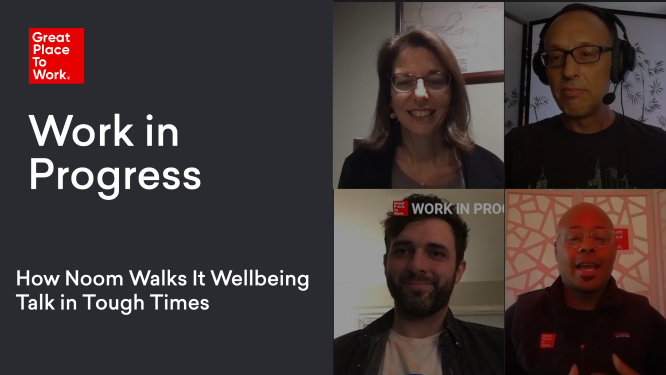Employee Experience, Employee Well-being
With more companies investing in well-being, leaders should use this day to commit to a year of effort.
After the pandemic, mental health has become a huge focus for employers.
In 2020, employees and employers spent almost $77 billion on mental health. At the beginning of 2022, 90% of employers said they were investing more in mental health programs.
Now the data is showing the juice is worth the squeeze.
A recent WHO study argues that investing in mental health globally could see companies recoup four times their investment. That means for every dollar spent, the overall U.S. economy would see $4 back in health outcomes and increased worker productivity.
Companies are also offering many workers better work-life balance.
In a July 2022 Great Place To Work® market survey of nearly 4,200 U.S. workers, 58% of employees reported they had a healthy work-life balance. That’s a gain of eight percentage points compared to a similar survey in 2021.
Great Place To Work research has proven the essential connection between employee well-being and key business goals like employee retention. Employees who experience well-being are three times more likely to stay with their employer and three times more likely to recommend their employer to others.
Yet, when it comes to mental health in the workplace, there’s a sharp divide between hourly and salaried workers. Only 48% of hourly workers at typical U.S. workplaces report psychological and emotional safety, compared with 58% of salaried workers, according to the Great Place To Work market survey.
Employees in health care and retail, in particular, are struggling to preserve mental health. At typical U.S. workplaces, only 43% of retail employees and 46% of health care workers report psychologically and emotionally healthy work environments.
Making a difference
Oct. 10 is World Mental Health Day, which provides the perfect opportunity for organizations to commit to increasing mental well-being for all employees.
The good news: No matter what industry your business operates in, you can create a healthy workplace for your employees. For example, despite the lower-than-average well-being scores for employees in health care after more than two years of pandemic crisis, the best health care workplaces are bucking the trend.
If you’re ready to start building a better workplace for your people, here are some of the best practices from companies that are one of the Fortune 100 Best Companies to Work For®:
1. Hire well-being coaches.
If employee well-being is truly a business imperative, it has to be staffed like any other business goal.
At Synchrony, No. 25 on 100 Best list for 2022, a team of well-being coaches help personalize wellness offerings for each employee. The company defines a well-being coach as “a supportive guide who partners with employees to create a personalized wellness strategy based on strengths and values.”
The diverse team of coaches is able to help employees work towards their own goals, from fitness to mental resilience. Equally important, the team of coaches matches the diversity of Synchrony’s overall workforce across gender race, sexual identity, and more — allowing employees to connect with experts who have first-hand knowledge of the unique challenges they might face in the workplace.
2. Increase access to licensed therapists.
Normalizing and encouraging employees to consult mental health professionals can destigmatize the practice.
Atlassian, No. 47 on the 100 Best list for 2022, has a global network of licensed therapists employees can access for up to 10 in-person or virtual visits per year.
Make sure your employees know about the benefits offered as part of your Employee Assistance Program (EAP). If employees feel comfortable sharing stories about how they used the EAP, it could encourage colleagues to also make use of available resources.
3. Focus on resilience.
Happiness is a poor metric to understand employee well-being. Instead, experts recommend focusing on resilience.
At Accenture, No. 6 on the 100 Best list in 2022, the Thrive wellness program offers many different tools for employees to build mental resilience. One part of the program, Thriving Mind, offers a self-directed digital experience that helps employees develop resilience and a sense of belonging.
About 210,000 Accenture employees participate globally, and the tool has created an 11% average increase in those workers’ ability to manage stress at work.
Cisco, No. 1 on the 100 Best list in 2022, also has programs that target employee resilience. Its mindfulness program, Mind Set, offers learning journeys grounded in neuroscience that teach participants cognitive strategies to build resiliency, boost mental stamina, and unlock creative thinking.
4. Partner with employee resource groups (ERGs).
Different parts of your employee population face different mental health challenges. When the U.S. withdrawal from Afghanistan in 2021 had an effect on veterans, employers like Dow, No. 99 on the 100 Best list in 2022, took action.
Dow’s ERG for veterans, VetNet, elevated the discussion regarding the mental health of veterans, the safety of women, and the ongoing political dynamics in Afghanistan in conversations across the company. All 10 of Dow’s ERGs collaborated to support veterans and their families, and highlight the importance of EAP resources.
Make sure leaders are partnering with these employee groups to identify mental health triggers and source ideas for offering support and relief.
5. Share powerful employee stories.
A key indicator for employee well-being is when workers report having meaningful connections with colleagues. One of the best tools to create those connections is storytelling.
On World Mental Health Day in 2021, Deloitte wanted to help employees share personal stories about their journeys with mental health. The company, No. 24 on the 100 Best list, used employee stories to drive an important message: “It’s OK to not be OK.”
Deloitte also produces podcasts that offer practical guidance and tips to support and protect mental health. One episode, “The Impact of Not Being Me,” shared personal stories on how exhausting it can be to hide your true self, and how speaking up and being open can bring joy and confidence.
Supporting employee well-being takes more than one day of action. Leaders should think of how this World Mental Health Day can be a springboard for a year of effort, and how they can make changes to support the well-being of every employee.
Survey your employees
Track year-over-year performance to highlight where action planning efforts are making an impact.











